
by wemakedo | Oct 6, 2017 | family, Plastic Free July |
“The wind of change is blowing through this (continent) country. Whether we like it or not, this growth of national consciousness is a (political fact) possibility?”.
– British PM Harold Macmillan in speech given in South Africa concerning decolonisation (with some modification)
Here in the WeMakeDo household, we try to ensure that we are at least considerate of our impact on our surroundings as best we can. We try to bring this perspective into all our family decisions because we feel it is a must for the sake of our kids’ future and the state of our surroundings.
With ridding ourselves of single-use plastic as our current focus, sometimes arguing over who “buckled” and bought another plastic bag of frozen peas or who owns the plastic water bottle that appeared in the bin may seem like we have nothing better to do. But to make the change stick, it’s important to question everything and to realise why it’s worth questioning these seemingly trivial everyday household decisions.
“When you bought that plastic bottle, you assumed responsibility for it now being part of our collective waste pile and for being a burden on the environment that your children will have to deal with as it hangs around for a hundred years!”. etc. etc. finger wagging included.
We don’t quite go that far….usually.
It’s easy to sometimes think that for every plastic bag of peas you forego (even though you love peas), that there are so many more being purchased and discarded that it can’t possibly make any difference. But it’s also important to remember that, as with any shifts in popular thinking, lots of seemingly small efforts to change the status quo can lead to tipping points in social behaviour which will then transform what is deemed acceptable behaviour by the majority. Think of smoking in public buildings or the use of plastic bags in supermarkets in our recent past. Granted these high profile changes were enforced by law in Ireland but how quickly they were accepted and generally lauded gives hope for other more subtle approaches to causing a change in our attitudes.
We have started to notice a significant groundswell of new awareness around environmental issues in Ireland in the last few months which looks to be part of a fabulous next step towards bringing the issues to national attention. There seem to be many new efforts now that when viewed collectively, seem like we have turned a corner in Ireland and people are taking this problem seriously.
Perhaps Mr D. Trump has inadvertently given rise to a reaction against his position on climate change that may, in the long run, bring about more change than if he hadn’t tried to declare it an overblown hoax.
Here are just a few examples we were delighted to learn about in recent weeks:
 Recently, you may have noticed the “conscious cup”advertising campaign encouraging people to bring their own cup when buying coffee. From a group of simply “concerned individuals” active on the Zero waste Facebook page, this effort aims to raise awareness about the approximately 200million cups we dispose of in Ireland (15 minutes after we purchase them).
Recently, you may have noticed the “conscious cup”advertising campaign encouraging people to bring their own cup when buying coffee. From a group of simply “concerned individuals” active on the Zero waste Facebook page, this effort aims to raise awareness about the approximately 200million cups we dispose of in Ireland (15 minutes after we purchase them).
Few people would argue in favour of this behaviour but until it’s pointed out to us, then it’s easy to just do as we’ve always done.

Cool Planet Experience and the EPA have launched a Cool Planet ambassadors program which will focus on educating the general public about how to respond to Climate Change:
“Once selected, the Cool Planet will train the 26 Cool Planet Champions to engage, educate and inspire the general public in their own county about how our changing climate directly impacts them and how they can make a real, practical difference.”

 In a similar program sponsored by An Taisce with support from the Department of Communication, Climate Action and Environment, National Climate Ambassadors are being appointed to help to stimulate awareness and change at a local level throughout Ireland. The program will look for the Ambassadors to take at least 4 specific actions in their locality aimed at raising awareness and educating the public on the effects of climate change in our lives.
In a similar program sponsored by An Taisce with support from the Department of Communication, Climate Action and Environment, National Climate Ambassadors are being appointed to help to stimulate awareness and change at a local level throughout Ireland. The program will look for the Ambassadors to take at least 4 specific actions in their locality aimed at raising awareness and educating the public on the effects of climate change in our lives.
 Voice Ireland have just finished recruiting for a recycling ambassador program on a national scale. This excellent program also aims to bring about change in our waste habits by means of education. The focus here is on improving recycling rates in Ireland and trying to remedy a national issue with the poor quality of our recycled waste. This large program aims to hire 25 paid ambassadors to help educate people on household waste management and how to recycle correctly as well as collect feedback on issues encounte
Voice Ireland have just finished recruiting for a recycling ambassador program on a national scale. This excellent program also aims to bring about change in our waste habits by means of education. The focus here is on improving recycling rates in Ireland and trying to remedy a national issue with the poor quality of our recycled waste. This large program aims to hire 25 paid ambassadors to help educate people on household waste management and how to recycle correctly as well as collect feedback on issues encounte red. It seems that while in Ireland the amount of recycling waste generated is reasonably high, the quality of this recycled waste stream is not so good due to cross contamination. We’re not so good and putting things in the correct place to ensure the individual recycling or composting waste streams are “clean”.
red. It seems that while in Ireland the amount of recycling waste generated is reasonably high, the quality of this recycled waste stream is not so good due to cross contamination. We’re not so good and putting things in the correct place to ensure the individual recycling or composting waste streams are “clean”.
The hope is that this program will generate useful feedback for government bodies to use in making the process easier for people to use, leading to improved levels of recycling.
 Another example we were delighted to read about this effort in the Dail led b
Another example we were delighted to read about this effort in the Dail led b y the Green Party to legislate for reduced packaging:
y the Green Party to legislate for reduced packaging:
Bill entitled: An Act to provide for a ban on single-use non-compostable cups and other tableware and for the introduction of deposit and return schemes for beverage containers
The proposed bill which has yet to make its way through approval aims to ban non-biodegradable coffee cups and other tableware.Hopefully, this overdue response to a significant source of landfill waste will be successful.
To help understand the incentives which may be helping to drive this increased focus we have been noticing, the EPA publishes a report on how we are doing nationally on our waste handling. This report shows our performance against EU targets set for Ireland and it appears we are doing quite well.
In the table below, (ref: EPA- Progress towards EU waste targets – August 2017) the 2020 goals for “recycling” (paper, metal plastic and glass) as well as for waste quantities to landfill are shown. We were probably no waste angels in 1997 – the year our targets are compared to but dropping to 35% of that amount in 23 years sounds impressive. Having met our 2013 reduction goals, it’s looking good for the 2020 goals also, but clearly, more focus is needed to make sure this stays on track.

It’s very inspiring to see groups like Voice Ireland, “Zero wasters” and others stepping up to contribute to this transition process and make us pay attention. Mrs WeMakeDo was delighted to be awarded one of the ambassador roles in the Voice Ireland program and is looking forward to helping with their process.
Shifting people’s habits on a national scale takes dialogue, focus and a lot of effort, but it’s how the big results can eventually come about. Let’s hope we are witnessing a new tipping point in Ireland and that these great initiatives can cumulatively swing us in a new direction for the better.
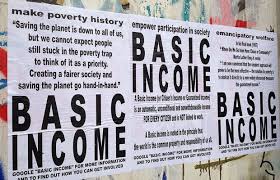
by wemakedo | Sep 8, 2017 | community, family |
This concept of a Universal Basic Income for all has been doing the rounds for a long time now and re-emerges regularly when some newsworthy person or other decides to be an advocate. Recently Mark Zuckerberg (Facebook CEO) delivered a commencement speech to US Harvard graduates in which he called for “exploring a system of wealth distribution known as Universal Basic Income”. And so followed a renewed flurry of commentary about this groundbreaking concept and how it might work. Or how it could never work.
The WeMakeDo family has been trying for some time now to experiment with tightening up our household annual costs and at the same time considering how we would live if we were to stop living off salaries from for-profit companies. Mrs WeMakedo started her own business a few years ago (the Babymarket.ie) which has been thriving but is not sufficient to sustain us yet. Mr WeMakedo has been considering ending his salaried position of 20 years simply because it no longer meets any of the higher order needs that can become more important to us as we get older.

You know that itch of the soul that starts to become harder to scratch as routine and monotony starts to kick in. Working for someone else can get a little wearisome and usually change is a good thing to bring upon ourselves.
A regular salary is nice and comforting but it can be detrimental to your motivation and creativity. Unless you are one of the lucky few who love what they are salaried to do, then its seems there is a limit to how much enthusiasm one can continue to generate for someone else’s agenda when they are paying you to do it. Some would say that a regular salary is the best way to stifle creativity and ingenuity. As the insightful author Nassim Taleb (author of “The Black Swan”) has said, “The three most harmful addictions are heroin, carbohydrates and a monthly salary”.
Of course one has to be practical too and ensure that family needs that we determine to be important, can be, and will continue to be met. But in a society where self-worth has become strongly attached to one’s “career” position and one’s outwardly displayed signs of high income, we are in danger of losing sight of what really satisfies us. And when you start to figure that out, then if a salaried job isn’t in some way aligned with those sources of satisfaction, then it needs to be seriously delivering in other ways to make it continue to be worthwhile.
For some people, that satisfaction may truly come from driving an expensive car to work at a company where we feel our position also commands respect from peers. But for some, this career path we are sold may turn out to not bring that deeper satisfaction we are craving. For some like myself, it just seems to take longer for the realisation to occur and then for some decisive action to follow.
Universal Basic Income is the idea that a government will pay every citizen some guaranteed regular amount to live-on so that their basic needs can always be met. It is not intended as a means to allow people to live without contributing to society. In fact, the model intends (and some evidence suggests) that by being freed from the stress and/or monotony of having to find a way to meet one’s basic needs, it will allow for larger sections of society to engage in fulfilling and still productive activities. The model assumes that the societal gain from this approach to funding people’s basic cost of living should outweigh the direct financial costs of funding the UBI.
At its most basic, UBI will lift a large section of society out of poverty. With this approach, everyone will have enough money to live to a basic standard. The UBI also may also help growing populations deal with the emerging trends in industry which suggest that as automation and artificial intelligence take hold, there will be fewer manual or menial jobs available for the population in general.
What will the masses do if there are no factories to get mind-numbing work in? Well, they’ll probably figure out better ways to use their time. Happier people should lead to improved general well-being, health and community engagement.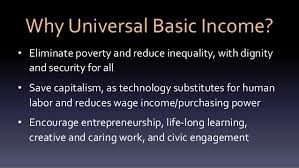
Some would argue that the free market model we currently follow in the capitalist world will force those in need of a salary to survive by whatever means is available to them, to become more inventive about how they meet their needs. But it’s hard to see how this forced creativity can be as good for society as a whole (or as enjoyable) as the unforced creativity afforded by the presence of a basic income in a UBI society.
The question of where the funding for the Basic income comes from seems somewhat contentious. In most proposed versions, taxes are raised to do this. Thus, a large scale redistribution of wealth would take place, from those who can afford to pay which is then used to stimulate the less well-off in society. In this model, it is expected that those less well-off people will now tend to put more of the (UBI) wealth back into the economy and thereby grow it significantly. In other words, after the initial shock of the increased taxes subsidies, the overall economy will grow significantly to the point where the tax burden of providing UBI is no longer felt as a burden.
All well ‘n good if you’re not part of the wealthy section of society that will feel like it has to pay for this experiment. But there is a well researched economic thesis that suggests that as the wealthy in society become more wealthy, they are stifling economies by hoarding this wealth. As they control more and more and prefer not to spend it (in order to stay wealthy), this tends to have a dampening effect on the economy.
We currently try to get around these stagnating economic scenarios by the use of “stimulus” packages such as we have seen in many countries since the 2007 financial crisis. Most often this takes the form of government infrastructure spending on roads and bridges, thereby indirectly forcing large sums of money into circulation or, also by simply printing more money for banks to loan out to borrowers which tends to be used in the US economic model. These are also just different means of infusing a stagnant economy with large amounts of cash.
Is distributing this money to individuals to use for their basic needs that much different to what we are now doing in times of economic difficulty?
It is also argued by those against the UBI, that without the incentive to work, the majority of people simply won’t do anything. And the funny thing here is that many of us tend to think that “of course I would want to be productive, but its those other (insert some adjective to describe those we think of as inherently lazy) who wouldn’t bother”.
Actual test cases of the UBI in action have shown that very small reductions in the numbers who want to work are observed and in some cases an increase in numbers takes place.
The truth here is that we all need to feel valued and to feel we contribute to our social circles in some way. And so small experiments in use of UBI have already shown that the numbers of those being productive will tend to go up rather than down once basic needs are met. The difference with a basic income in place is that the life-happiness measures go up a lot when the choices for how you make your contribution not hampered by the need to earn a salary from them.
Imagine how much more creativity we would see in such unrestricted societies?
For lots of info on what is happening to progress the Universal Basic Income movement, visit http://basicincome.org/
Now back to work.
For at least a little while longer.
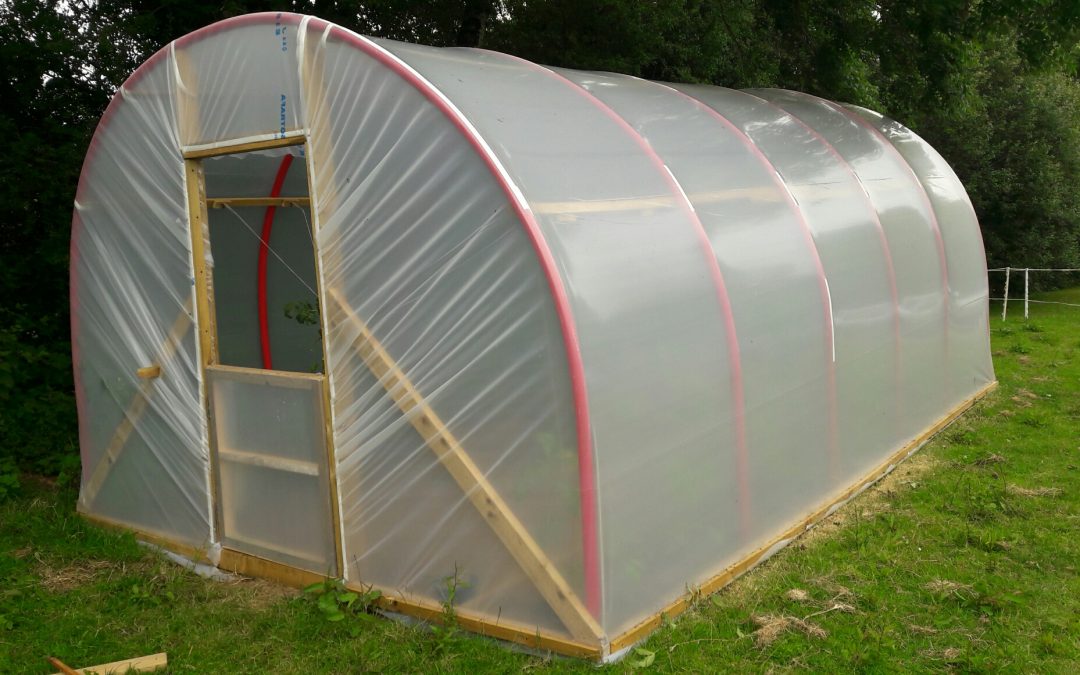
by wemakedo | Jul 27, 2017 | garden, Uncategorized |
We were delighted to finally finish our poly-tunnel in early June, just in time to transplant a batch of 20 tomato plants from pots into their new home, before they started wilting in their pots.
The plastic (polythene) cover proved to be quite easy to attach to the frame to complete the structure. (OMG! – did we just blow our whole year’s household efforts to avoid plastic – out of the water!! – we did think about this…)
The secret is to stretch it across the length of the tunnel first (from door to door) and then stretch it from side to side moving from one side to the same position on the other side to pull it taut in between. We used 2×1 sections screwed into the base boards to fix the polyethene in place. One person pulling to apply tension and the other person fixing. This process worked well with two of us helping, and we had the cover fitted in a half a day. Note also that it’s best done on a sunny day with no wind. The sun will warm the plastic and make it easier to stretch fully. This ensures it stays tight during hot weather times. The heat tape applied to the supports did make it easier to pull and stretch the plastic without risking any damage where it came into contact with rough timber. So although it may not be necessary to prevent burning of the plastic during its lifetime as it’s not in contact with any material that will heat-up, it did seem worthwhile just as a smooth contact surface in certain locations.
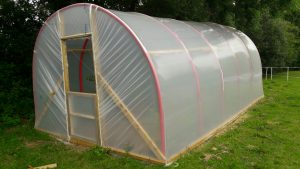 We opted to go with a half door at the front (lower half can be seen in the picture shown) so the top half can be left open for ventilation, while the other end has a large, (as yet open) vent. We figured that as much ventilation as possible is best for now until the weather turns bad again, so we haven’t finished those openings off yet.
We opted to go with a half door at the front (lower half can be seen in the picture shown) so the top half can be left open for ventilation, while the other end has a large, (as yet open) vent. We figured that as much ventilation as possible is best for now until the weather turns bad again, so we haven’t finished those openings off yet.
All in all, it was quite manageable and we are happy with our cost estimate of about half the price to build it as to buy a kit, although that doesn’t account for the time cost in putting it together which was significant.
Once the shell was finished, we used remaining 2×4” lengths to lay out the beds inside. We opted for 2 foot wide beds at the sides where access was restricted to one side, while a 3-foot wide centre bed left two sufficiently wide 2 foot paths running the length of the space. A little extra room was also left around the door for an eventual work surface or just room to “potter”. We had hoped to also include space for the kids as this may turn into a nice winter-time sheltered play area for them to get out of the house. That’s another day’s work though.
We have yet to figure out a good water supply and are opting to run a long hose from our house supply over to it for now. Eventually, we plan to collect the rainwater from the tunnel itself to use inside for plant watering. It seems this can be done easily using a stuck-on strip of plastic to guide the water off the wall a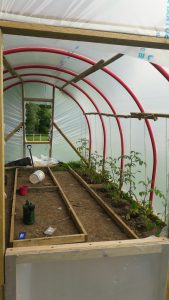 nd in
nd in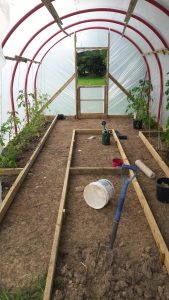 to a butt. We plan to look into this further.
to a butt. We plan to look into this further.
An interesting side note at this point is that our tunnel happens to be right beside where our deep water well (200ft) is located. So in effect, we are pumping water out of the ground, sending it into the house, through it, back out again and over to our polytunnel next to the water source. In the spirit of self-sufficiency which we are all about, we did some investigation into manual well-pumps.
We have semi-regularly been caught out without power for hours at a time. While it’s never been anything more than a few hours, still it can be quite an inconvenience if it goes beyond this, with water supply being the first problem we would encounter as we use a pressurised system.
Being self-reliant for our water supply, it’s nice to know where our water comes from and to know its quality to some degree, but we are entirely dependent on our electricity supply to access the water we need. So, what about a major disruption of power in the event of a serious storm?
It seems that photo-voltaic powered pumps are not powerful enough to lift water from such a depth, but there are manual pumps which can do this. Interestingly the major suppliers of these seem to be US based as there is quite a market there for off-grid survival enthusiast equipment. There just don’t seem to be the same options available closer to home. Perhaps we are too trusting of our service providers over here?
One example is the Bison Deep well pump which is a very expensive option but appears to be very well made and capable for such deep wells. ANother example is shown here. These pumps are about $1500 to $2000, but are well engineered and made to last. We haven’t done anything about this yet, but the idea of being able to hand- pump water for our polytunnel and for our home in the case of emergency is appealing. We don’t want to go too “survivalist” on you, but one just never knows. We all tend to be too accustomed to our comforts to really give any thought as to how we could manage in emergency situations, which can and do happen in various parts of the world.
Shortly after we finished and were admiring our work, someone accidentally had a run in with the side of the tunnel leaving a large gash in the polythene. This was, of course, always going to happen at some point, but within days of completing it! anyway, make sure to get some of the polythene repair tape sold by polytunnel suppliers for repairing the holes. It seems to work reasonably well.
Now, all we need is the sun to get our tomato crop blooming.
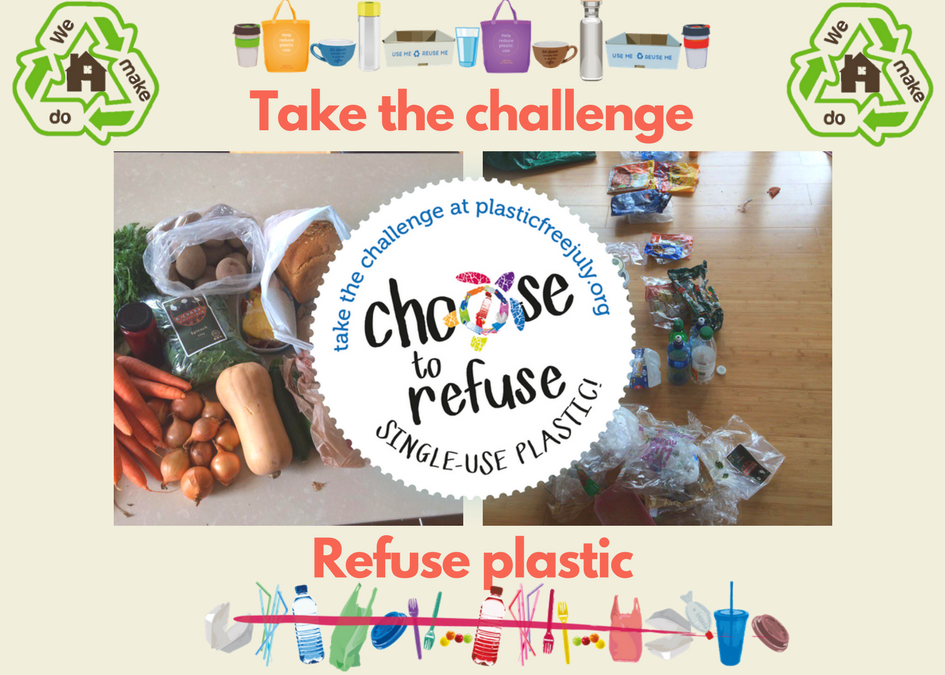
by wemakedo | Jun 29, 2017 | Plastic Free July, reuse, Uncategorized |
It’s been a year since we dabbled in Plastic Free July 2016 and now it’s upon us again.We’re happy to say that we have more enthusiasm to try it out again this year and are already well positioned in that many of our plastic-free habits have stayed with us since last year.
The biggest difference for us this year has been in going with a local fruit and veg seller who manages to remove all the packaging from his produce and will deliver to our home weekly. The other change we made is that we can purchase from a wholesale bulk foods distributor based in Macroom (http://www.iihealthfoods.com/) who carries everything you could want in large quantities.
For our first trial run, we bought:
25Kg of porridge oats (in a paper sack), 25Kg of puy lentils, 25Kg of red lentils, 25Kg or brown rice, 20kg of raisins
This is just an experiment to see how well the stuff holds and how long it lasts. In some cases, the cost savings are not much, but the reduced packaging and time spent purchasing seem well worth the effort. We are also still buying bulk nuts from www.nutsinbulk.ie, although haven’t convinced those guys to try removing the plastic from their supplies.
Sigh…only to have a bulk food store locally…we think this would really work as a business, but so far it hasn’t happened yet as far as we know.
This year rather than just try harder to keep the single-use plastic out of the house, we are setting a couple of specific goals for ourselves during the month.
- Get self-sufficient on milk alternatives
- Find other options for laundry detergent and toothpaste
As we have moved away mostly but not completely from cow’s milk, for health reasons, we have started buying more and more of the expensive non-dairy options, such as soya milk, almond milk, coconut milk, rice milk, oat milk, and my personal favorite, a coconut and almond milk blend. Lots of options to choose from and they are quite expensive to buy (€2 to €2.6 per litre), not to mention all the tetra packaging that goes with them.
What’s more shocking about these milk alternatives, is that many of them use minuscule amounts of the main ingredient (2-5%!!) and most of what you are buying is water with some sweetener and stabilizers added. Once you spot this on the pack ingredients, the idea of making you own is a lot more palatable.
And none of them are hard to make, although they can be a little time consuming. But in each case we’ve tried so far, they taste better than the store-bought options.
We opted for an easy start with coconut milk. Our first experiment used a can of light coconut milk we happened to have. One recipe looked particularly simple and called for just diluting a can with 2 cans of water and adding salt and vanilla flavoring to taste. It was quite palatable – certainly no worse than the market bought versions. The preferred method for this is to soak shredded coconut, rather than starting with the canned milk, which tends to have water and other stuff added to start with.
 Then we tried almond milk – letting a cup of almonds sit for 2 days in the fridge in water to allow them to soak and release an acid that is best removed. Then they were drained and rinsed, fresh water was added (2 cups for 1 cup of nuts) and blended at high speed. Some sweeteners of choice can be added to flavor, such as honey, vanilla or even dates blended in. This one worked really well and got the thumbs up from the kids.
Then we tried almond milk – letting a cup of almonds sit for 2 days in the fridge in water to allow them to soak and release an acid that is best removed. Then they were drained and rinsed, fresh water was added (2 cups for 1 cup of nuts) and blended at high speed. Some sweeteners of choice can be added to flavor, such as honey, vanilla or even dates blended in. This one worked really well and got the thumbs up from the kids.
The coconut milk didn’t get much support, but then neither did the shop bought stuff either.
Rice milk is a little more time consuming to make. It requires you to boil the rice in advance and then use the rice to blend with water. Then add vanilla or cinnamon to taste as usual. Not that hard and quite tasty too.
For now we’re going with almond milk in quantity to see if we can get into the habit of making do with it. Apparently it should last for a few days in the fridge, so reasonably sized batches will work
For our #2 goal this time round, we recently attended a “Zero Waste” event in Dublin and managed to source some options for laundry detergent and toothpaste. The detergent is apparently condensed soap shavings which can be used to dilute into detergent of varying strength. Rather ambitiously, the two jars (reused also) we bought should apparently last for a year. We’re a little skeptical but getting ready to try it out.
For the toothpaste, we bought some dry powdery “stuff” – a sort of clay with all sorts of healthy things added in apparently. I think its Bentonite clay – at least I hope it is – which has excellent absorbing properties, presumably absorbing stuff that you don’t want on your teeth. The idea is to add a little powder to the wet toothbrush and the particles of clay will do the cleaning job as you scrub without damaging tooth enamel. The other natural ingredients serve to fight bacteria. So far we have noticed that one’s teeth do feel very clean after using it, but I for one miss that minty fresh taste you get from standard pastes. The jury is still out on this stuff for now – one for and one against.
So we have mostly removed the plastic from our food supplies by now, but WOW does it spread around the house through other means when you’re not paying attention! Having children makes this so much harder as much of what seems to come their way is made of plastic and has a very short lifespan.
Also, changing topics, our Poly-tunnel is finally up and running now so we’ll let you know how that’s working out in the next update.
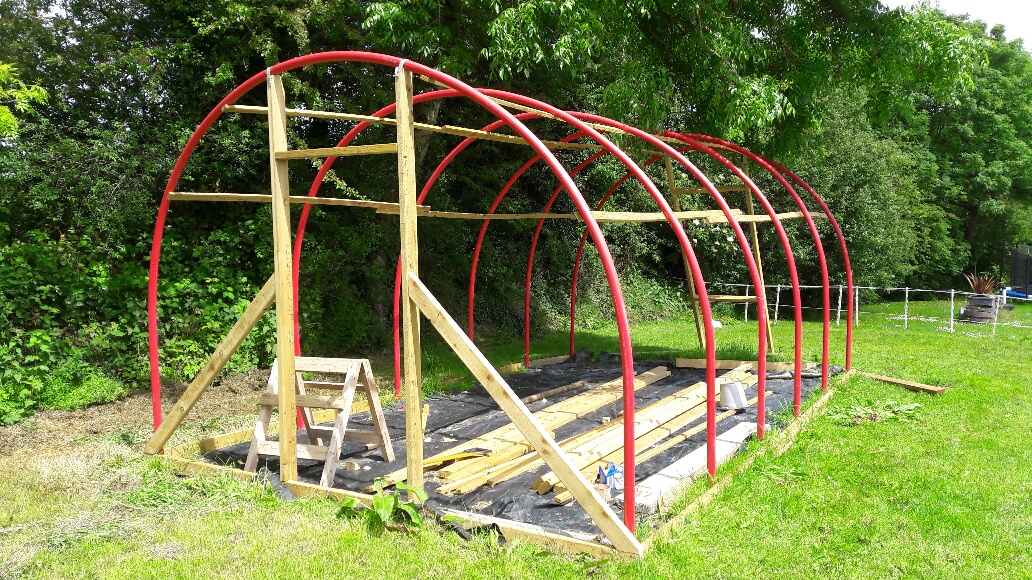
by wemakedo | Jun 2, 2017 | Uncategorized |
No self-respecting self sufficiency enthusiast should be without a polytunnel for some amped up veggie growing. Being able to produce your own veggies at home brings satisfaction for all sorts of reasons: providing for your family, true organic food, experimenting with stuff. This is assuming that one is able to get the stuff to grow. But that’s not our concern yet. Firstly we needed to build the tunnel and so we started some research into ways to make your own.
Having read through many diy descriptions, we opted to go for a design that uses polythene piping to make the arches. In the description we were following most closely, 2” diameter black polythene water pipe was used. For some reason we couldn’t source this so instead opted for ESB ducting, which comes in a nice 50m roll for about Euros80, and is widely available. Next up we needed some steel pipe that would be hammered into the ground to act as anchor points for the poly pipe arches. This steel pipe needs to fit inside the poly pipe. So we used 1” galvanised pipe which although it didn’t give a snug fit with the ducting, the result was still secure once the ducting was pushed down over the 3ft or so of steel above ground. We had hoped to make 7 arches at 4ft spacing, giving a 24ft long tunnel, but measuring the coiled ducting accurately proved to be difficult and so when it came to the last arch, we were short. So we have 6 arches at 4ft spacing for a 20ft long tunnel. The 7.5 meter arch span gave us an 11ft wide tunnel with a good high headspace (8.5ft).That’s still a lot of room for veggies (if they grow)! You’ll notice the sloping end wall at one end. That was simply an effort to add a little more floor area inside without the additional arch.
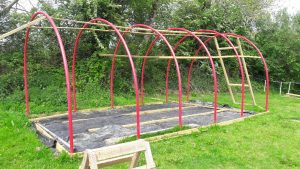
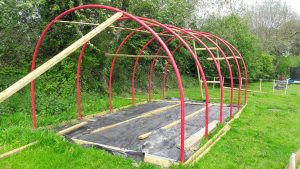
We visited some neighbors who are polytunnel pro’s to get their advice and experience.It seems that good ventilation is very important to get right. we were told It can be helped by ensuring you have a tall tunnel (with openings at either end). Hence the 8.5 ft height. The plan was to have a regular half door at one end, top half to be left open as a vent. While the other end was to have a tiltable vent or similar area. You can see the size of this vent are in the lower end in the images above. Hopefully this would be enough.
Next we went with some 4×2 pressure treated timber to use for the base rail to which the polythene would be attached as well as for the end structures to form the door and vents. Some 2×1 lengths were used to link the arches together and add rigidity to the structure. It seems that used scaffold boards are a nice and cheap way to do the base rail and provide a large area to attach the polythene too, but try as we could we weren’t able to find a local source at a reasonable price. It seems that many people are finding many uses for the surplus of scaffold boards that used to be around, and so they are now becoming a much sought after commodity for diy projects. An alternate design to the use of timber baserails, is to dig a trench all around the tunnel and bury the end of the polythene under a 1ft depth of soil. With the recent dry weather we’d been having, we figured this would be back breaking so at additional expense and less ideally we went with new 4×2 lengths.
While the structure was still being built….it is taking a while as there seems to be so much other stuff going on now with the fine summer weather…we ordered the polythene cover online from this company (www.polytunnelsdirect.ie).
An 11m by 8.75m section of 800g material we were told would be ample for our needs. We also ordered some heat tape, which is recommended for areas where the polythene touches metal or anything rough. The metal will get hot and damage the integrity of the polythene over time while any rough areas will obviously cause risk of tearing.The order arrived within a few days and is sitting waiting…

Our materials costs were as follows:
Steel pipe sections to hold up red pipe arches = €60
red ducting :€88
Timber (4x2s (10) + 2x1s (10)) = €140
polythene + heat tape = €170
total = €460;
Its a little more than I had expected for such a structure. While we are estimating that an equivalent kit purchased and delivered would cost at least twice that amount which is somewhat consoling, the labour time involved in building this so far has been significant. However there is plenty of satisfaction in taking on projects such as this yourself if you have the time to spend on it, so factoring in financial and time costs, is it still worth it?
Absolutely!
We hope to have at least the structure completed by the next blog update, even if the growing hasn’t kicked off. There is a healthy crop of tomatoes sitting in pots waiting for their new home and a chance to thrive in our new tunnel so time is becoming of the essence. We are a little late for this years growing season, but hope to get some growing use from the tunnel this year.


 Recently, you may have noticed the “conscious cup”advertising campaign encouraging people to bring their own cup when buying coffee. From a group of simply “concerned individuals” active on the Zero waste Facebook page, this effort aims to raise awareness about the approximately 200million cups we dispose of in Ireland (15 minutes after we purchase them).
Recently, you may have noticed the “conscious cup”advertising campaign encouraging people to bring their own cup when buying coffee. From a group of simply “concerned individuals” active on the Zero waste Facebook page, this effort aims to raise awareness about the approximately 200million cups we dispose of in Ireland (15 minutes after we purchase them).

 In a similar program sponsored by An Taisce with support from the Department of Communication, Climate Action and Environment, National Climate Ambassadors are being appointed to help to stimulate awareness and change at a local level throughout Ireland. The program will look for the Ambassadors to take at least 4 specific actions in their locality aimed at raising awareness and educating the public on the effects of climate change in our lives.
In a similar program sponsored by An Taisce with support from the Department of Communication, Climate Action and Environment, National Climate Ambassadors are being appointed to help to stimulate awareness and change at a local level throughout Ireland. The program will look for the Ambassadors to take at least 4 specific actions in their locality aimed at raising awareness and educating the public on the effects of climate change in our lives. Voice Ireland have just finished recruiting for a recycling ambassador program on a national scale. This excellent program also aims to bring about change in our waste habits by means of education. The focus here is on improving recycling rates in Ireland and trying to remedy a national issue with the poor quality of our recycled waste. This large program aims to hire 25 paid ambassadors to help educate people on household waste management and how to recycle correctly as well as collect feedback on issues encounte
Voice Ireland have just finished recruiting for a recycling ambassador program on a national scale. This excellent program also aims to bring about change in our waste habits by means of education. The focus here is on improving recycling rates in Ireland and trying to remedy a national issue with the poor quality of our recycled waste. This large program aims to hire 25 paid ambassadors to help educate people on household waste management and how to recycle correctly as well as collect feedback on issues encounte red. It seems that while in Ireland the amount of recycling waste generated is reasonably high, the quality of this recycled waste stream is not so good due to cross contamination. We’re not so good and putting things in the correct place to ensure the individual recycling or composting waste streams are “clean”.
red. It seems that while in Ireland the amount of recycling waste generated is reasonably high, the quality of this recycled waste stream is not so good due to cross contamination. We’re not so good and putting things in the correct place to ensure the individual recycling or composting waste streams are “clean”. Another example we were delighted to read about this effort in the Dail led b
Another example we were delighted to read about this effort in the Dail led b y the Green Party to legislate for reduced packaging:
y the Green Party to legislate for reduced packaging:
















